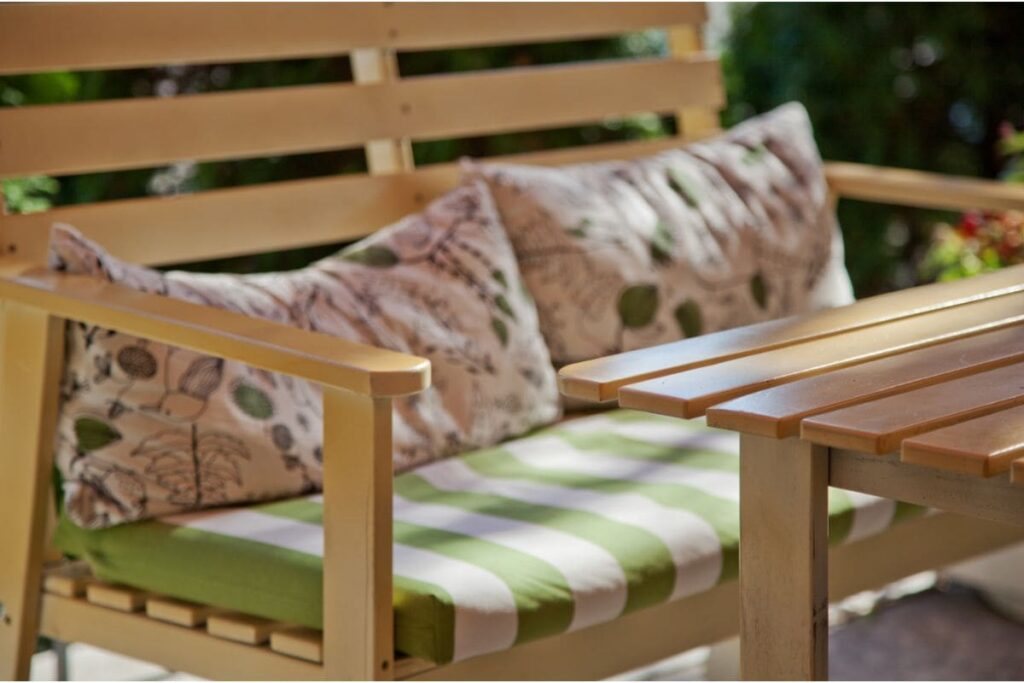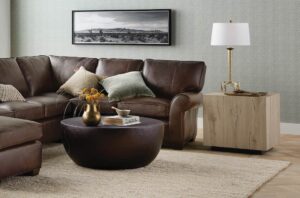Outdoor furniture can transform any outdoor space, but with so many brands in the market like Polywood vs Highwood, how do you make the best choice?
The consequences of a poor choice can range from financial loss to significantly less durability. Here, we’ll tackle these issues by focusing on two renowned brands: Polywood and Highwood.
This article aims to provide an in-depth comparison, touching on important aspects like sustainability, durability, aesthetics, and more, to help you make an informed decision.
Quick Comparison
| Attribute | Polywood | Highwood |
|---|---|---|
| Material Used | High-density polyethylene | High-grade poly material |
| Collections & Options | 27 collections | 4 brands, 3 focused on furniture |
| Durability & Strength | Weather-resistant | Weather-resistant, higher weight capacity in Sequoia line |
| Color Density | Color runs throughout | Maintains color in all conditions |
| Appearance | Less wood-like | More authentic wood appearance |
| Sustainability | Uses recycled milk jugs and bottle caps | Uses post-industrial materials |
| Warranty | 20 years for many products | 12 years, 20 years for Sequoia line |
| Price | Generally less expensive | Generally more expensive |
| Repair Suggestions | Advises against sanding | Recommends steel wool and wax |
Background and History of Polywood
Understanding the genesis and growth of Polywood can offer valuable insights into the brand’s commitment to quality and innovation.
This section aims to provide a detailed look at how Polywood came into existence, the initial products that set it apart, and its standing in the market today.
Origin and Foundation
Polywood was born in Syracuse, Indiana, with an innovative idea: to recycle plastic containers and transform them into durable furniture that could withstand the elements.
This unique approach set the company on a trajectory of growth and differentiation from the get-go. This early commitment to recycling and sustainability proved to be a winning strategy, attracting a strong customer base that shared similar values.
First Product Launched
The brand caught the public’s attention with its inaugural product—the classic Adirondack chair. What set it apart was the material it was crafted from: high-density polyethylene (HDPE), a type of plastic that ensures durability while mimicking the aesthetics of natural wood.
Note: The use of HDPE not only set Polywood apart from competitors but also introduced a new dimension to outdoor furniture, making it both eco-friendly and low-maintenance.
Market Leadership in HDPE Furniture
Over the years, Polywood has seen significant growth and has established itself as a market leader in HDPE furniture. With a broad product range, the brand has something for everyone. Yet, its major selling point remains the durability and ease of maintenance that comes with HDPE furniture.
These features have given Polywood an edge in the market, making it a go-to brand for customers looking for long-lasting solutions for their outdoor spaces.
We hope this section has provided a comprehensive understanding of Polywood’s history and market position. The brand’s focus on sustainable materials and durable products offers a glimpse into why it has become a household name in outdoor furniture.
Understanding Highwood’s Market Position
Highwood presents a compelling alternative to Polywood, offering unique features that make it stand out in the crowded outdoor furniture market.
In this section, we will delve into the foundational aspects of Highwood, the innovative materials it employs, and the specialized range it offers to customers.
Founding Story and Initial Focus
Established in 2003 in Pennsylvania, Highwood started with a distinct mission, encapsulated in its focus on “Carefree Backyard Living.” The brand aimed to provide consumers with aesthetically pleasing yet low-maintenance furniture options that closely resembled natural wood. This core focus has guided Highwood’s product development and helped it carve out a niche in the industry.
Material Innovation
Highwood stands apart through its use of a unique, high-grade poly material to produce furniture that not only mimics the appearance of real wood but also offers durability and weather resistance. This material innovation allows Highwood furniture to withstand various climatic conditions without requiring constant upkeep.
Note: Highwood’s Sequoia line stands out for its high weight capacity, making it an excellent choice for those seeking both style and strength.
Range and Specialization
The brand has a well-defined product range, divided into four brands, three of which are devoted to furniture. Each brand presents a set of unique features, designs, and functionalities aimed at different customer needs. From aesthetic appeal to durability, Highwood covers a broad spectrum of demands.
Understanding the market position of Highwood allows for a better grasp of the options available in the outdoor furniture sector. The brand’s emphasis on material innovation and specialized range adds layers to the consumer choice, making Highwood a noteworthy competitor to Polywood.
Sustainability Practices of Both Brands
The question of sustainability is increasingly significant in consumer choices today, particularly in the outdoor furniture market. Polywood vs Highwood are no exceptions, each incorporating sustainable practices into their business models.
This section will scrutinize how Polywood utilizes recycled material, Highwood’s use of post-industrial material, and the environmental benefits that stem from these practices.
How Polywood Utilizes Recycled Material
Polywood is known for its innovative use of recycled materials, specifically plastic milk jugs and detergent bottles. Once collected, these plastics are cleaned, processed, and transformed into high-density polyethylene (HDPE), the primary material for Polywood’s products.
| Polywood’s Sustainability Features | Details |
|---|---|
| Material Source | Recycled plastic jugs |
| Processing | Cleaning and converting |
| Final Material | HDPE |
Highwood’s Use of Post-Industrial Material
Highwood, on the other hand, employs post-industrial recycled plastic. This type of material comes from manufacturing waste that is then reprocessed for use in Highwood’s furniture. It’s a way to cut down on industrial waste, offering an eco-friendly yet durable option for consumers.
Note: Both brands have the advantage of diverting waste from landfills, albeit from different stages of the plastic life cycle.
Benefits to Environment
The environmental implications of these practices are multifaceted. Utilizing recycled or post-industrial material conserves natural resources and minimizes waste in landfills.
Additionally, both Polywood vs Highwood furniture require less maintenance, which reduces the need for harmful cleaning chemicals. This has a cascading positive effect on both air and water quality.
By investing in either Polywood or Highwood, customers are making a responsible choice that aligns with broader environmental objectives. This elevates the appeal of both brands while responding to the pressing issue of sustainable consumerism.
Analyzing Durability and Maintenance
Durability and ease of maintenance are key factors that influence the consumer’s decision in the outdoor furniture market. Polywood and Highwood offer distinct features in these areas.
This section will cover the weather resistance features of Polywood, the durability aspects of Highwood, and the cleaning recommendations for both brands.
Weather Resistance Features of Polywood
Polywood furniture is built to withstand extreme weather conditions. The high-density polyethylene (HDPE) used in the construction is resistant to rain, snow, salt water, and even UV radiation. This ensures that the furniture remains fade-resistant and does not crack or splinter over time.
| Polywood Weather Resistance | Features |
|---|---|
| Rain | Resistant |
| Snow | Resistant |
| Salt Water | Resistant |
| UV Radiation | Fade-resistant |
Durability Aspects of Highwood
Highwood focuses on durability through material innovation. Their proprietary synthetic wood offers the aesthetics of natural wood without the drawbacks. It does not rot, splinter, or suffer from insect attacks, offering a long-lasting furniture solution.
- Resistant to rot
- Impervious to splintering
- Immune to insect damage
Cleaning Recommendations for Both Brands
Maintaining Polywood and Highwood furniture is relatively straightforward. For Polywood, a simple wipe down with soap and water will suffice. Highwood furniture may require a specialized cleaner but generally maintains its luster with minimal effort.
Note: While both brands offer low-maintenance solutions, consumers should still follow the specific cleaning guidelines provided by the manufacturer to ensure the longevity of the product.
By focusing on durability and maintenance, Polywood vs Highwood have made significant strides in meeting consumer demands for long-lasting, low-care outdoor furniture.
Visual Aesthetics and Appearance
Visual aesthetics are more than just a superficial concern; they play a significant role in shaping customer preferences in outdoor furniture. The design, colors, and textures are vital considerations for consumers. Polywood vs Highwood approach these aspects quite differently.
This section delves into Polywood’s diverse color range, Highwood’s wood-like appearance, and the overall importance of aesthetics in making a choice.
Polywood’s Range of Colors and Textures
Polywood offers an expansive palette of colors, from subdued earth tones to vibrant hues. The textured finishes give an added layer of sophistication, providing options that can seamlessly blend with any outdoor setting.
| Colors Available | Textured Finishes |
|---|---|
| Earth Tones | Matte Finish |
| Vibrant Hues | Wood-grain Finish |
Highwood’s Authentic Wood Appearance
Highwood seeks to emulate the rich look of natural wood. The brand’s proprietary synthetic material has a texture that mimics wood grain, creating an authentic appearance that many find pleasing and natural.
- Mimics natural wood
- Texture feels like real wood
- Aesthetically pleasing
Importance of Aesthetics in Choice
The design and color scheme of furniture significantly influence buyer decisions. Outdoor furniture serves not just a functional but also a decorative purpose.
As such, the ability of Polywood to offer a range of colors and Highwood’s focus on authentic wood-like appearance are vital in fulfilling consumer expectations.
Note: When choosing between Polywood and Highwood, consider not just durability and price but also how the furniture will complement your outdoor setting.
By catering to different aesthetic preferences, both Polywood and Highwood have expanded their customer base, enriching the options available in the outdoor furniture market.
Cost and Warranty Considerations
The financial aspect of purchasing outdoor furniture is often as crucial as design and durability. Both Polywood and Highwood offer distinct pricing and warranty options, making it imperative for consumers to weigh these factors carefully.
This section elaborates on the pricing structure of each brand, their respective warranties, and how these considerations influence purchasing decisions.
Pricing Differences Between the Two Brands
Polywood is generally positioned as a more budget-friendly choice, offering a wide range of products that cater to various price points. Highwood, on the other hand, tends to be on the higher end of the pricing spectrum due to its focus on premium materials and intricate designs.
| Brand | Price Range | Target Market |
|---|---|---|
| Polywood | Budget-Friendly | Broad Consumer Base |
| Highwood | Premium | Niche Market |
Warranty Duration for Polywood and Highwood
When it comes to warranties, Polywood typically offers a more extended period, often up to 20 years. Highwood’s warranty duration is comparatively less but is generally commensurate with the premium quality of its products.
- Polywood: Up to 20 years
- Highwood: Ranges depending on the product
How Cost and Warranty Affect Decision
Both price and warranty duration are factors that could tilt the balance in favor of one brand over the other. While Polywood’s affordability and long warranty duration may attract a broader range of consumers, Highwood’s premium pricing and shorter warranty periods are indicative of its specialized market focus.
Note: Always read the fine print of warranty terms to ensure that you are adequately covered for possible issues.
The interplay between cost and warranty is an essential aspect of the decision-making process, guiding consumers toward a choice that best aligns with their needs and financial capabilities.
Conclusion
The comparison between Polywood vs Highwood brings us to several core distinctions, ranging from pricing and warranty to sustainability practices.
These differences serve as vital indicators for consumers aiming to make an informed decision. It is essential to balance multiple factors, including cost, aesthetics, and durability, before making a final selection.
Both brands have unique strengths that cater to different preferences, underlining the need for a thorough evaluation based on individual requirements.





